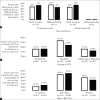Impact of a Maternal Prevention of Mother-to-child Transmission of HIV (PMTCT) Intervention on HIV-exposed Infants in Uganda
- PMID: 32765963
- PMCID: PMC7397331
- DOI: 10.21106/ijma.380
Impact of a Maternal Prevention of Mother-to-child Transmission of HIV (PMTCT) Intervention on HIV-exposed Infants in Uganda
Abstract
Background: Uganda has successfully reduced pediatric HIV infections through prevention of mother-to-child transmission of HIV (PMTCT) programs, yet little is known about adherence to infant-specific components of interventions. We hypothesized that infants born to mothers receiving the WiseMama (WM) electronic drug monitoring (EDM)-based adherence intervention would have increased uptake of six-week post-natal nevirapine (NVP) infant prophylaxis and better adherence to six-week early infant diagnosis (EID) HIV testing.
Methods: At two sites in Uganda, the Wise Infant Study (WIN) prospectively followed an infant cohort. Infants were born to women enrolled in an RCT testing the effect of real-time reminders delivered via EDM on maternal adherence to antiretroviral therapy. We assessed intrapartum and discharge receipt of NVP prophylaxis using pharmacy and infant HIV DNA testing laboratory data.
Results: Of 121 women eligible for WIN, 97 (80%) consented and enrolled; 46 had been randomized to control and 51 to intervention. There were no differences in receipt of a six-week NVP supply (control 87%, intervention 82%, p = 0.53). Receipt of any NVP prophylaxis did not vary by delivery location (p = 0.35), and although 12% of infants were delivered at non-study health facilities, they were not less likely to receive NVP at discharge (p = 0.37). Among infants with a completed HIV test, there was no difference in mean time to first test (control 52 days (SD 18), intervention 51 days (SD 15), p = 0.86). Only one infant, in the control group, tested positive for HIV.
Conclusion and global health implications: We found no significant differences in adherence to infant PMTCT practices between intervention and control infants with relatively high rates of NVP receipt albeit with suboptimal adherence to six-week EID testing. Further work is needed to ensure improved access, uptake, and follow-up of HIV-exposed infants in the Option B+ era.
Keywords: Antiretroviral therapy prophylaxis; Early infant diagnosis; HIV; HIV-exposed infants; Nevirapine; Prevention of maternal to child transmission of HIV.
Copyright © 2020 Murillo et al.
Conflict of interest statement
Conflicts of Interest: No conflicts of interest for any authors to disclose.
Figures



Similar articles
-
Efficacy of Mobile phone use on adherence to Nevirapine prophylaxis and retention in care among the HIV-exposed infants in prevention of mother to child transmission of HIV: a randomized controlled trial.BMC Pediatr. 2021 Apr 20;21(1):186. doi: 10.1186/s12887-021-02660-w. BMC Pediatr. 2021. PMID: 33879118 Free PMC article. Clinical Trial.
-
Uptake and performance of prevention of mother-to-child transmission and early infant diagnosis in pregnant HIV-infected women and their exposed infants at seven health centres in Addis Ababa, Ethiopia.Trop Med Int Health. 2017 Jun;22(6):765-775. doi: 10.1111/tmi.12881. Trop Med Int Health. 2017. PMID: 28407452
-
HIV Resistance and Prevention of Mother-to-Child Transmission Regimen in HIV-Infected Infants in Northern Tanzania.AIDS Res Hum Retroviruses. 2017 Nov;33(11):1107-1113. doi: 10.1089/AID.2017.0025. Epub 2017 Oct 5. AIDS Res Hum Retroviruses. 2017. PMID: 28797181 Free PMC article.
-
Use of peers, community lay persons and Village Health Team (VHT) members improves six-week postnatal clinic (PNC) follow-up and Early Infant HIV Diagnosis (EID) in urban and rural health units in Uganda: A one-year implementation study.BMC Health Serv Res. 2015 Dec 15;15:555. doi: 10.1186/s12913-015-1213-5. BMC Health Serv Res. 2015. PMID: 26666331 Free PMC article.
-
Improved access to early infant diagnosis is a critical part of a child-centric prevention of mother-to-child transmission agenda.AIDS. 2013 Nov;27 Suppl 2:S197-205. doi: 10.1097/QAD.0000000000000104. AIDS. 2013. PMID: 24361629 Review.
Cited by
-
Analysis of Related Factors of Mother-to-Child Transmission of AIDS and Evaluation of Measures to Prevent Mother-to-Child Transmission.Comput Math Methods Med. 2022 Jan 5;2022:3190370. doi: 10.1155/2022/3190370. eCollection 2022. Comput Math Methods Med. 2022. Retraction in: Comput Math Methods Med. 2023 Sep 27;2023:9860218. doi: 10.1155/2023/9860218. PMID: 35035518 Free PMC article. Retracted.
References
-
- United Nations Children's Fund. For Every Child, End AIDS:Seventh Stocktaking Report, 2016. 2016. Dec, [Accessed April 3 2020]. https://www.unicef.org/publications/
-
- Fowler MG, Lampe MA, Jamieson DJ, et al. Reducing the risk of mother-to-child human immunodeficiency virus transmission:past successes, current progress and challenges, and future directions. American Jounral of Obstetrics and Gynecology. 2007;197(3 Suppl):S3–9. - PubMed
LinkOut - more resources
Full Text Sources
Miscellaneous
